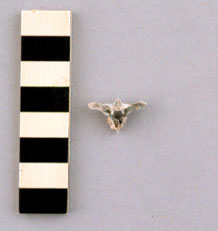

Animal vertebra from cremation urn KM 2903.
These bones may have been added to the assemblage at a later date to increase the value of the urn and its contents on the modern day black market. This commonly occurs in cases where locals discover ancient burials and try to make a profit from their findings. The fact that several animal bones were also found in the cremated remains also suggests this is a viable explanation, since it is unlikely that animals would have been mixed with the original cremation. Another possible explanation for the extra bones is that the cremated remains of another family member or slave may later have been placed in the same urn with the original burial. It is unlikely we will ever know the true story.
**Please note: this "assemblage" was created solely for educational purposes. While the cremation urn KM 2903 and its contents may reflect an actual burial (it was purchased in the 1920's in Puteoli, Italy), the other objects in this "assemblage" (inscription, columbarium, and melted glass) do not come from the same archaeological context. A full explanation of this class project is found on the introductory page for this website.


